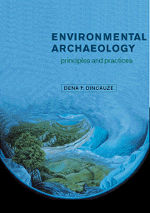Book contents
- Frontmatter
- Contents
- List of figures
- List of tables
- Preface
- Acknowledgments
- Glossary
- PART I INTRODUCTION
- 1 ENVIRONMENTAL ARCHAEOLOGY AND HUMAN ECOLOGY
- 2 CONCEPTS FOR PALEOENVIRONMENTAL RECONSTRUCTION
- 3 MECHANISMS OF ENVIRONMENTAL CHANGE
- 4 HUMAN RESPONSES TO ENVIRONMENTAL CHANGE
- PART II CHRONOLOGY
- PART III CLIMATE
- PART IV GEOMORPHOLOGY
- PART V SEDIMENTS AND SOILS
- PART VI VEGETATION
- PART VII FAUNA
- PART VIII INTEGRATION
- References
- Index
3 - MECHANISMS OF ENVIRONMENTAL CHANGE
Published online by Cambridge University Press: 20 January 2010
- Frontmatter
- Contents
- List of figures
- List of tables
- Preface
- Acknowledgments
- Glossary
- PART I INTRODUCTION
- 1 ENVIRONMENTAL ARCHAEOLOGY AND HUMAN ECOLOGY
- 2 CONCEPTS FOR PALEOENVIRONMENTAL RECONSTRUCTION
- 3 MECHANISMS OF ENVIRONMENTAL CHANGE
- 4 HUMAN RESPONSES TO ENVIRONMENTAL CHANGE
- PART II CHRONOLOGY
- PART III CLIMATE
- PART IV GEOMORPHOLOGY
- PART V SEDIMENTS AND SOILS
- PART VI VEGETATION
- PART VII FAUNA
- PART VIII INTEGRATION
- References
- Index
Summary
Palaeoexperiments inevitably lack the rigour of true experimental science. Whilst a combination of replication, statistical validation, ingenuity and intellectual honesty can limit and constrain spurious reinforcement, the circumstantial nature of so much post hoc evidence, and the judgemental nature of critical aspects of sampling and interpretation will still influence the conclusions drawn.
OLDFIELD 1993: 18–19Human beings perceive environmental change mainly as change in the state (qualitative character or structure) or condition (quantitative composition or amount) of nearby communities of living organisms, or of the weather. For example, a change of state for living communities might be gains or losses in the diversity of plants or animals represented; a change in condition might be an increase or decrease in the numbers of plants and animals. For the weather, a switch fromwinter rains to predominantly summer rains in mid-latitudes would constitute a change in state, whereas a marked decrease in precipitation over a month or more would be a change in condition. We notice such changes, because they violate our expectations that things vary little from year to year. Our experience and observations of the environment are at the local scale and are mediated by language and opportunity, so that each of us has a slightly different idea of things. Because of thewaysweperceive environmental change, our “commonsense” leads us to seek the causes of change wherewe perceive it – among living communities and in the weather systems. Recent research in geophysics and climatology has demonstrated that this approach is oversimplified and misleading.
- Type
- Chapter
- Information
- Environmental ArchaeologyPrinciples and Practice, pp. 36 - 62Publisher: Cambridge University PressPrint publication year: 2000

